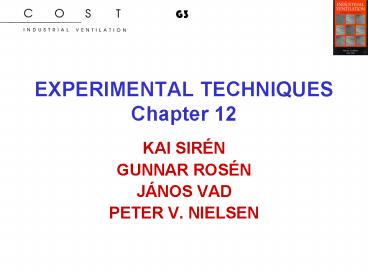EXPERIMENTAL TECHNIQUES Chapter 12 - PowerPoint PPT Presentation
1 / 12
Title:
EXPERIMENTAL TECHNIQUES Chapter 12
Description:
EXPERIMENTAL TECHNIQUES. Chapter 12. KAI SIR N. GUNNAR ROS N. J NOS VAD. PETER V. NIELSEN ... VISUALIZATION OF AIRFLOW AND CONTAMINANT DISPERSION ... – PowerPoint PPT presentation
Number of Views:47
Avg rating:3.0/5.0
Title: EXPERIMENTAL TECHNIQUES Chapter 12
1
EXPERIMENTAL TECHNIQUESChapter 12
- KAI SIRÉN
- GUNNAR ROSÉN
- JÁNOS VAD
- PETER V. NIELSEN
2
Contents of Chapter 12
- INTRODUCTION
- VISUALIZATION OF AIRFLOW AND CONTAMINANT
DISPERSION - Direct Observation of Aerosols Enhanced by
Special Light - Smoke Generation
- Flow Indicators
- Thermocamera Methods
- Graphical Presentation of Area Measurements
- Graphical Presentation of Measured Parameters in
a Video - References
- MEASUREMENT TECHNIQUES
- Introduction
- Measurement Planning
- Treatment of Measurement Uncertainties
- Dynamics of Measurements
- Temperature Measurement
- Air Humidity Measurement
- Pressure Difference Measurement
- Velocity Measurement
- Flow Rate Measurement
- Laser-Based Techniques (by Janos Vad)
- Nomenclature
- References
- SCALE-MODEL EXPERIMENTS
- Introduction
- Governing Equations and Dimensionless Numbers
- Similarity Principles and Conditions for Model
Experiments - Model Experiments in the Case of Fully Developed
Turbulent Flow - Model Experiments in Connection with the Local
Ventilation in the Industrial Environment - Labratory Experiments with General and Local
Ventilation - Using Similarity Principles in Planning
Experiments - References
3
INTRODUCTION
- The use of experimental techniques is one method
of designing, testing, and commissioning
ventilation systems. - A variety of complex problems are encountered in
the wide field of industrial ventilation, the
most common being the acceptability of airflow
and temperature related to a new or rebuilt
system. - A complicated problem would be to experimentally
investigate the influence of a hot oven on the
airflow patterns in a large hall and how it
influences the thermal conditions at the
workplace. - Ventilation engineers require answers to many
difficult questions not only at the design stage,
but at the commissioning and operating stage as
well.
4
INTRODUCTION
- The carrying out of visualization techniques or
measurements is one approach to obtain answers to
these questions. - Computer simulation is another method that is now
becoming a more exact science. - A third, essential approach is to depend on
experience and good engineering judgment. - All the above methods may eventually lead to
success however, the effort and cost of the work
may differ considerably. - This chapter describes the measurement and
visualization techniques that can be applied in
industrial ventilation problems.
5
INTRODUCTION
- In planning experimental work, the following
approach can be used - Set goals What information is required as an
output of the exercise? - Select an experimental approach visualization,
full-scale measurements, reduced-scale
measurements - Select measurement methods
- Ensure reliable analysis of results
- Select instruments
- Install and test the instrumentation
- Carry out the measurements
- Treat basic data to achieve the desired
information
6
FIGURE 12.4 Three examples of smoke sources
line, surface, and three-dimensional.
7
FIGURE 12.7 Thermocamera picture visualizing
exposure to nitrous oxide during surgery (a)
without nitrous oxide in the breathing zone (b)
with nitrous oxide. (Picture from B. Ljungqvist.)
8
Measurement Techniques
- In the wide field of industrial ventilation many
factors require measurements to be carried out. - One of the most common is the commissioning of a
new or a renovated ventilation system. In this
case the client has to see that the system works
according to the specifications made with the
consulting engineer, manufacturer, and
contractor. - Many other situations require quantitative
information on ventilation and related systems,
like - The satisfactory functioning of a ventilation
system, - Troubleshooting in existing facilities,
- Testing the dynamics of subsystems, such as
controls, - Determining reasons for complaints,
- Checking on specified target values in a space,
- Carrying out an energy audit,
- Collecting data for renovation planning, and
- Collecting boundary values for a computational
approach.
9
Laser-Based Techniques
- In addition to their widespread use in research
and development in fluid dynamics, laser-based
techniques are also suited to experiments in
industrial ventilation. - The use of these advanced experimental methods is
reasonable when their advantages in comparison
with traditional measurement techniques
counterbalance the significantly higher expenses
of instrumentation.
10
SCALE-MODEL EXPERIMENTS
- One of the methods used for the determination of
airflow in large spaces is model experiments. - This method is also useful in the study of local
ventilation around a working area in the
industrial environment.
11
SCALE-MODEL EXPERIMENTS
Scale-model experiments have been used to study a
variety of ventilation problems as air movement
in a room, air movement around a building, energy
flow in a building, contaminant distribution at
an operators workplace, and smoke movement in a
building on fire.
12
FIGURE 12.39 (a) Vortex exhaust at a concrete
element factory, (b) laboratory model of
the vortex exhaust, and (c) simplified model of
the exhaust.































